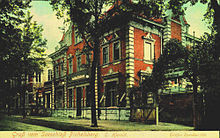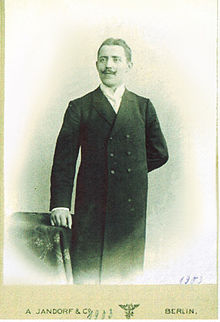Lake castle Pichelsberg
The Seeschloss Pichelsberg was a popular restaurant on the Stößensee in Berlin-Westend .
Empire
From 1899 to 1900, Conrad Herold , whose property stretched from the lakeshore up to the Pichelsberg, built the well-known excursion restaurant Seeschloß for his son Erwin Conrad Hans Herold (born December 18, 1876 in Berlin, † December 7, 1950 in Bartelshof near Alt Thymen ) Pichelsberg am Stößensee . The excursion restaurant, which was popular in the German Empire, stood on an area of around 10,000 m², which had a 160-meter-long waterfront on the Stößensee. The dance hall, which could hold up to 1000 visitors, was decorated with the precious so-called Monhaupt glass paintings. This involved around 60 individual portraits from the family tree of the Hereditary Prince Bernhard von Meiningen , which are said to have been created around 1888. Conrad Herold bought the windows at an auction around 1899 for 2100 marks. To finance the construction of the Seeschloss, Conrad Herold had taken out a loan from A. Busse & Co. AG in Berlin , which he could no longer repay. He had already lent his extensive property around the Pichelsberg from the beginning of the 1890s, the Pichelsberg lake castle did not generate the necessary funds. After the death of Conrad Herold at the end of the empire, the property was foreclosed , which was now completely transferred to A. Busse & Co. AG in Berlin.
Weimar Republic and Third Reich
A. Busse & Co. AG in Berlin sold part of the site on December 23, 1920 to Pichelsbergerhöhe Grundstücksgesellschaft mbH . In the turmoil of war during the battle for Berlin, the Pichelsberg Castle was plundered and the hall with the glass windows was destroyed.
After 1945

In April 1953, the Pichelsberg lake palace was still being used as a refugee home, but in the same year Universum Film AG leased the excursion restaurant as an alternative studio. But already in 1956 the producer Gero Wecker took over the studios with the Arca-Filmgesellschaft from Göttingen. After German-German reunification, films were shot in addition to television productions in the Havelchaussee film studio in the former Pichelsberg Castle . B. in 2005 the film Enigma by Volker Schlöndorff .
literature
- Hans E. Pappenheim: The Belvedere on the Pichelsberg , in: Martin Henning and Dr. Heinz Gebhardt (ed.): Yearbook for Brandenburg State History , Volume 7, Berlin 1956, pp. 25–34
- Märkisches Provinzialmuseum (Ed.): Brandenburgia - Monthly newspaper of the Society for Local History of the Province of Brandenburg , Berlin 1908
Web links
Individual evidence
- ^ Klaus Wille: 42 walks in Charlottenburg and Spandau. Berliner Kaleidoskop, Volume 17, Verlag Bruno Hessling, Berlin 1976, p. 69.
- ^ Märkisches Provinzialmuseum (ed.), Brandenburgia - Monthly newspaper of the Society for Local History of the Province of Brandenburg, Berlin 1908, p. 262
- ↑ Hans E. Pappenheim, The Belvedere on the Pichelsberg, in: Martin Henning and Dr. Heinz Gebhardt (Ed.), Yearbook for Brandenburg State History, Volume 7, Berlin 1956, p. 33
- ↑ Hans E. Pappenheim, The Belvedere on the Pichelsberg, in: Martin Henning and Dr. Heinz Gebhardt (Ed.), Yearbook for Brandenburg State History, Volume 7, Berlin 1956, p. 37
- ↑ Hans E. Pappenheim, The Belvedere on the Pichelsberg, in: Martin Henning and Dr. Heinz Gebhardt (Ed.), Yearbook for Brandenburg State History, Volume 7, Berlin 1956, p. 37
- ↑ http://www.cinegraph.de/etc/ateliers/arca.html on May 1, 2015
Coordinates: 52 ° 30 '37.4 " N , 13 ° 13' 37.7" E

